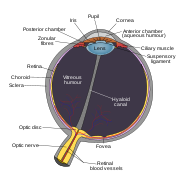
Foveal
Encyclopedia

Retina
The vertebrate retina is a light-sensitive tissue lining the inner surface of the eye. The optics of the eye create an image of the visual world on the retina, which serves much the same function as the film in a camera. Light striking the retina initiates a cascade of chemical and electrical...
that permits 100% visual acuity. The line-of-sight is a virtual line connecting the fovea
Fovea
The fovea centralis, also generally known as the fovea , is a part of the eye, located in the center of the macula region of the retina....
with a fixation
Fixation
Fixation may refer to the following:In science:*Fixation , the state in which an individual becomes obsessed with an attachment to another human, an animal, or an inanimate object...
point in the outside world.
The discovery of the line-of-sight is attributed to Leonardo Da Vinci
Leonardo da Vinci
Leonardo di ser Piero da Vinci was an Italian Renaissance polymath: painter, sculptor, architect, musician, scientist, mathematician, engineer, inventor, anatomist, geologist, cartographer, botanist and writer whose genius, perhaps more than that of any other figure, epitomized the Renaissance...
.
His main experimental finding was that there is only a distinct and clear vision at the line-of-sight, the optical line that ends at the fovea. Although he did not use these words literally he actually is the father of the modern distinction between foveal vision (a more precise term for central vision) and peripheral vision
Peripheral vision
Peripheral vision is a part of vision that occurs outside the very center of gaze. There is a broad set of non-central points in the field of view that is included in the notion of peripheral vision...
.

The modern diagram to the right shows that the fovea is a sort of pit. The Latin word fovea actually means pitfall.

